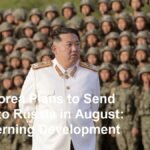Pyongyang, March 27, 2025 — North Korean leader Kim Jong Un showcased a new fleet of artificial intelligence (AI)-enabled “suicide drones” during a high-profile military demonstration on Thursday, marking a significant escalation in the regime’s pursuit of advanced asymmetric warfare capabilities. The drones, described by state media as “tactical reconnaissance-strike systems,” are designed to autonomously detect and destroy enemy targets on land and sea, raising alarm among regional adversaries and global observers.
A Display of Technological Ambition
The demonstration, held at a undisclosed coastal site, featured a live-fire exercise in which multiple drones successfully identified mock enemy vessels and ground installations using AI-driven surveillance sensors. According to the Korean Central News Agency (KCNA), the drones combine “real-time spy functions” with kamikaze-style attack capabilities, enabling them to loiter over conflict zones, gather intelligence, and—once a target is confirmed—self-detonate with precision. Analysts note that the systems appear tailored to counter U.S. and South Korean naval assets, including aircraft carriers and missile defense batteries.
Kim Jong Un, clad in his signature black trench coat, hailed the drones as a “revolutionary leap” in North Korea’s defense strategy. “Our scientists have achieved the glorious task of merging the limitless potential of AI with our Juche-oriented military tactics,” he declared, referencing the regime’s ideology of self-reliance. “No hostile force can evade the watchful eyes and merciless strikes of our invincible drones.”
Technical Specifications and Strategic Implications
While North Korea has not released detailed technical data, defense experts speculate the drones operate using a combination of machine learning algorithms, facial recognition software, and satellite-linked navigation. Their purported ability to distinguish between civilian and military targets—a claim met with skepticism by Western analysts—suggests advancements in target discrimination, a critical hurdle in autonomous weapons systems.
The drones’ dual role as surveillance tools and explosive devices also poses a strategic challenge. Unlike traditional munitions, these systems can remain airborne for extended periods, mapping enemy movements before selecting high-value targets. This capability could complicate defensive measures for South Korea and Japan, both of which rely heavily on early-warning systems to counter North Korean missile threats.
“This is a game-changer in asymmetric warfare,” said Dr. Lee Sang-min, a Seoul-based military analyst. “By deploying swarms of low-cost, AI-guided drones, Pyongyang can overwhelm regional missile defenses while gathering intelligence. It’s a cost-effective way to level the playing field against technologically superior adversaries.”
International Reactions and Concerns
The demonstration drew swift condemnation from the United States, South Korea, and Japan. The U.S. State Department called the drones “destabilizing” and accused North Korea of “recklessly exploiting AI to threaten global security.” South Korea’s Joint Chiefs of Staff announced plans to accelerate its own drone defense programs, including laser-based interception systems.
Human rights organizations and AI ethicists also voiced alarm, citing the moral risks of autonomous weapons. “Machines should not decide when to take human lives,” said a spokesperson for the Campaign to Stop Killer Robots. “This development underscores the urgent need for international regulations on AI in warfare.”
A Broader Pattern of Escalation
The drone unveiling follows a series of provocative actions by North Korea in early 2025, including the testing of a solid-fuel intercontinental ballistic missile (ICBM) and cyberattacks targeting South Korean infrastructure. Kim’s regime has increasingly emphasized drone technology since 2023, when it allegedly acquired components from foreign suppliers despite UN sanctions.
Notably, the March 27 test coincided with U.S.-South Korea joint military drills, a recurring trigger for North Korean aggression. Some analysts interpret the timing as a message to Washington and Seoul: Pyongyang is prepared to deploy new, unpredictable tools to counter “imperialist aggression.”
What’s Next?
The international community now faces pressing questions. Will North Korea export these drones to rogue states or militant groups? Can sanctions effectively curb the flow of AI technology to the isolated regime? And how will rival nations adapt their militaries to counter AI-driven threats?
For now, Kim Jong Un seems intent on cementing North Korea’s status as a “techno-military power.” As state media broadcast footage of the drones soaring over the East Sea, one message rang clear: in the era of AI warfare, the Hermit Kingdom is determined to stay ahead of the curve—no matter the cost.












